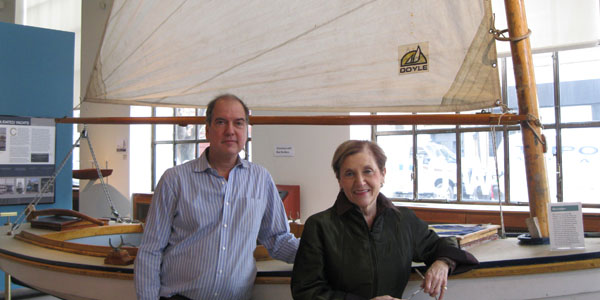
This winter, the hardy souls at ArtsWestchester in White Plains have gone down to the sea in ships, as it were, for an exhibit that charts the past and present of the maritime tradition in our area.
While “From Shore to Shore: Boat Builders and Boatyards of Westchester and Long Island” (through March 9) is primarily about marine history here, dating from the late 18th century, and aesthetics, it also offers viewers a portal onto the craft and business of making and maintaining boats in a fluid economy.
“I think people are wondering why ArtsWestchester is doing a boat-building exhibit,” says Executive Director Janet T. Langsam. “But we”™ve done exhibits on stone walls and other crafts. There are techniques being demonstrated here that we need to hold on to.”
Indeed, Tom van Buren ”“ director of folk arts and performance at ArtsWestchester, who curated the show with Nancy Solomon of Long Island Traditions ”“ says that the youngsters who built wooden boats in the educational programs run by the Bronx-based Rocking the Boat and Peekskill”™s Community Boat Works of the Hudson Valley are also learning carpentry, math and social skills that can be applied to a variety of trades and careers. Rocking the Boat”™s green and blond Whitehall rowing boat certainly looks impressively sleek, all the more so when you consider that it was built by teenagers.
Rocking the Boat also contributed the exhibit”™s melonseed, a type of sailboat that would”™ve plied the mid-Atlantic in the mid-19th century, helmed by fishermen or sportsmen. Its 16-foot mast makes nice use of the lofty two-story Peckham Gallery in ArtsWestchester”™s Arts Exchange headquarters, says gallery director Kathleen Reckling.
Nowadays, however, boats are no longer built out of woods like cedar and white oak, says Van Buren. They”™re made from fiberglass and metals like aluminum.
Among those swimming against the tide is Chris Brennan, who builds and repairs wooden boats at Westerly Marina in Ossining, where he rents space.
“Most of the people who have wooden boats today are collectors,” says Joe DeMarchis, manager of Westerly Marina, a third-generation family business founded in 1961 by Joe”™s father, Arthur. It”™s one of the boatyards featured in the exhibit along with Julius Petersen Boatyard in Nyack, Derecktor Shipyard in Mamaroneck, Maurice”™s Yacht Service in New Rochelle, Consolidated Yachts on City Island and several on Long Island.
The shift to materials that required less upkeep for boat owners changed the business locally, Joe DeMarchis says.
“Fiberglass boats are made from a mold, and that”™s done mostly in the South,” he says.
While companies like Derecktor Shipyard ”“ begun in 1947 by Robert E. Derecktor and continued today by son Paul ”“ still build custom sailing and motor yachts, high-speed ferries and workboats, much of the maritime industry in this area revolves around restoration and storage, Van Buren says.
At Westerly Marina, the DeMarchis family sells new boats, repairs older ones, including sailboats and Jet Skis, and berths about 200 boats in winter. How much business there is depends on everything from boating regulations to the economy, which DeMarchis says hasn”™t recovered yet locally.
And then there”™s the matter of a perfect storm otherwise known as Hurricane Sandy. Westerly Marina saw a five-foot surge from the Hudson River that covered the top of shelving, damaged some machinery and otherwise made “quite a mess.” But thanks to a strong seawall, the marina itself was safe.
The result, DeMarchis says, was a little bit of everything. Some boat owners have taken the insurance money and run. Some are rebuilding. Some are buying new boats.
The DeMarchis family isn”™t going anywhere. There is, Joe says, a democratic camaraderie among boatmen, who might be lawyers or electricians, a respect for both the beauty and the terror of the sea.
“We”™re here for the duration,” he says.
There”™s something else that Van Buren hopes would remain, too: “The overarching message of the exhibit is a celebration of a time when we made things here. It”™s something to think about as we go forward.”


















